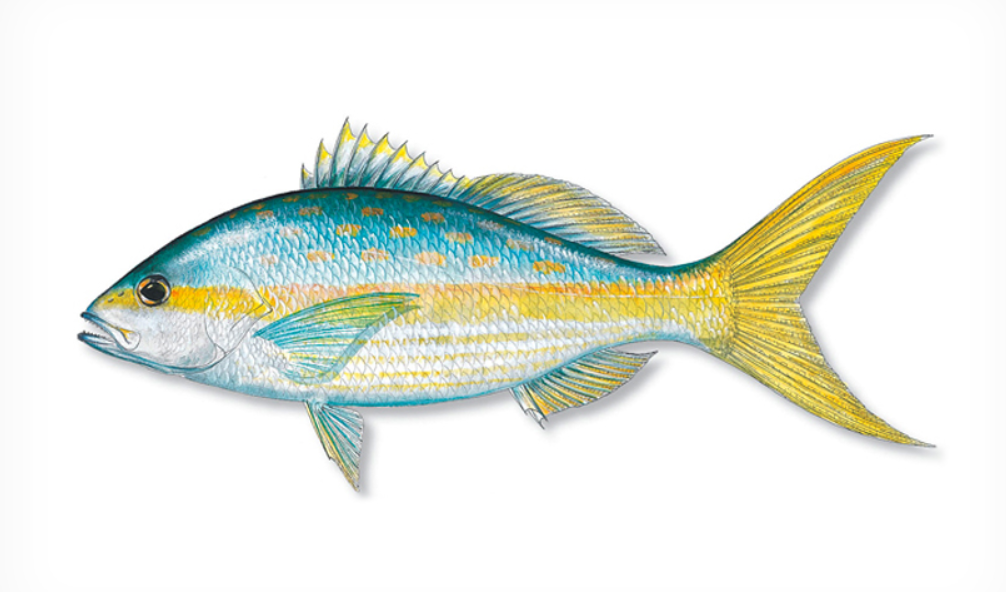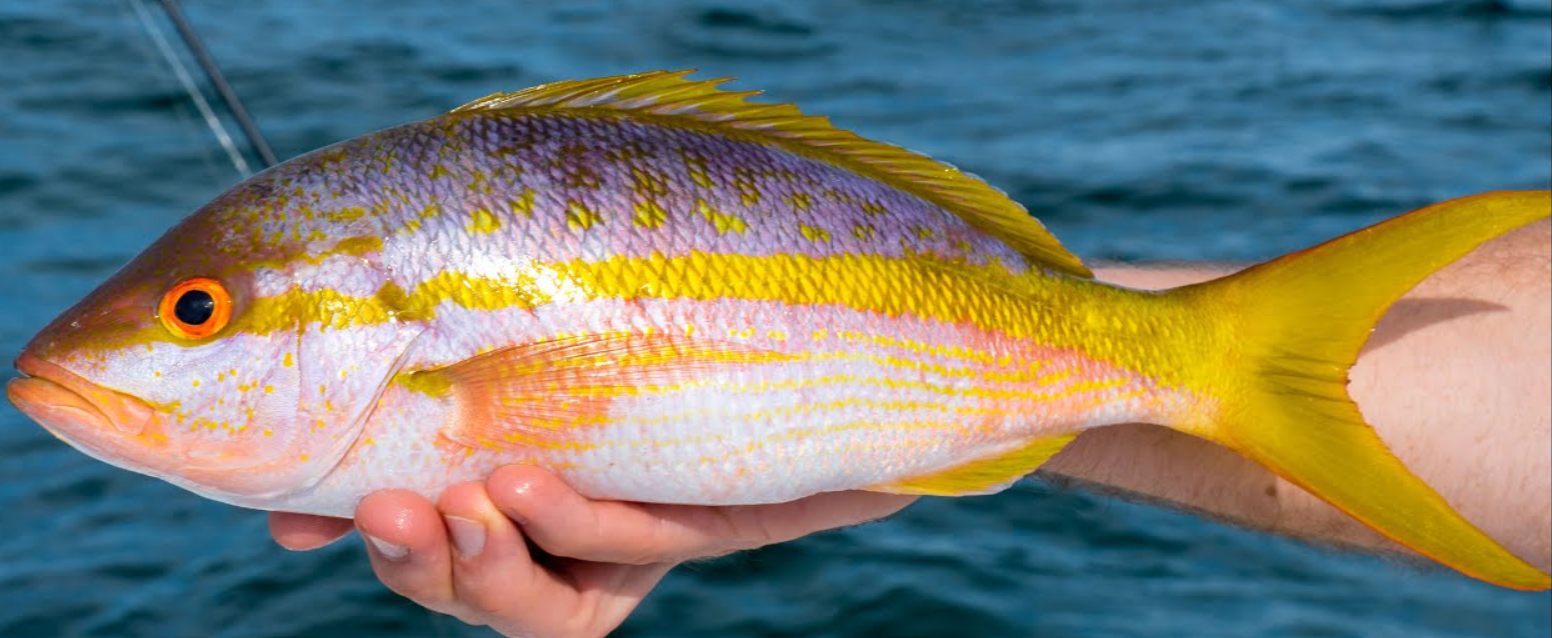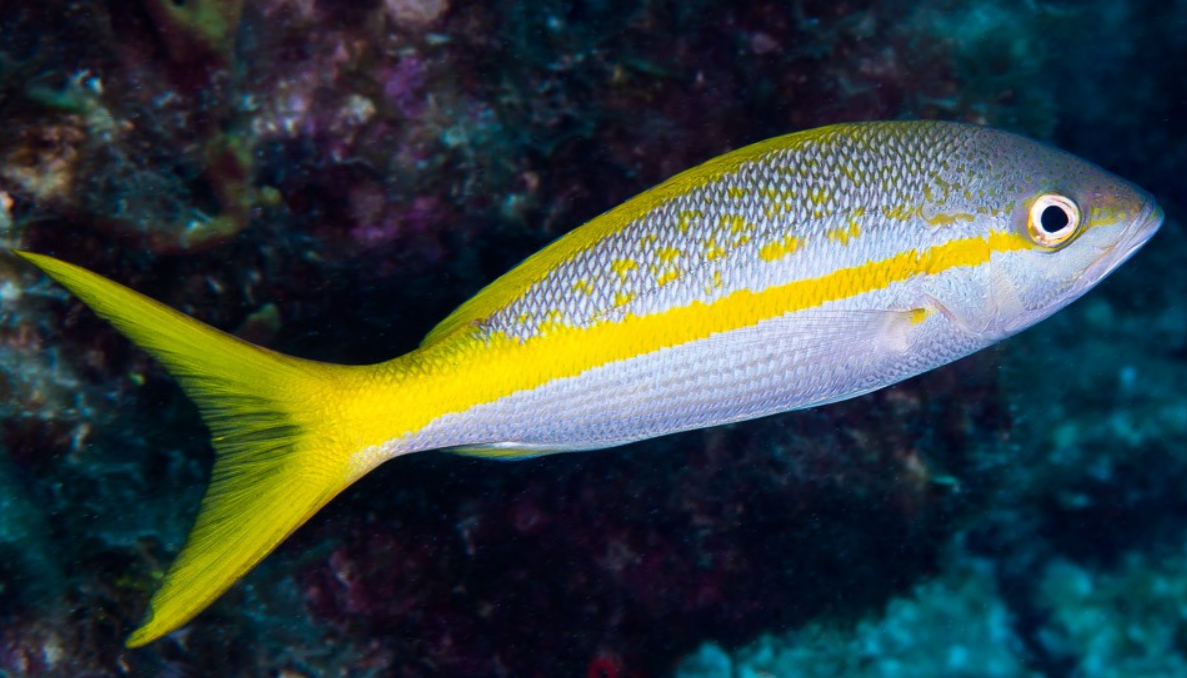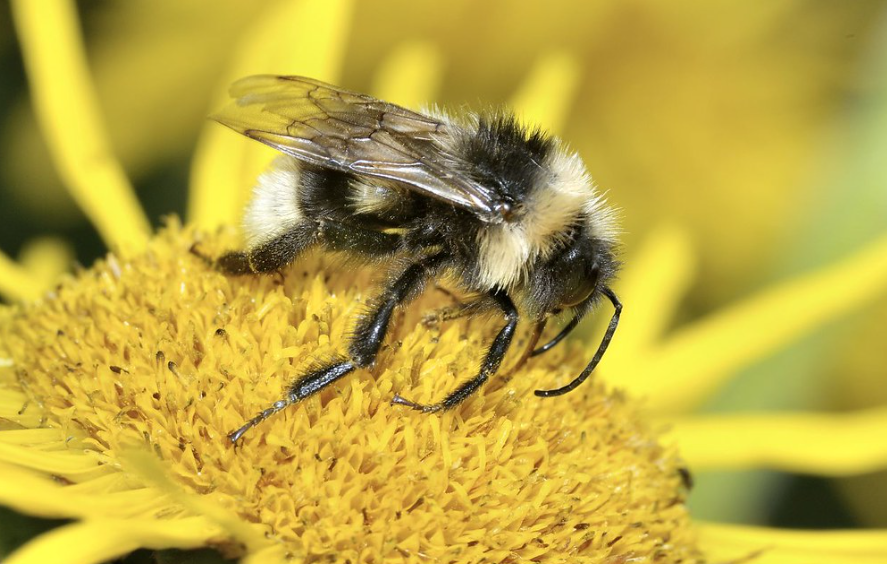
Quick Top 10 Facts about Yellowtail Snapper
| SCIENTIFIC NAME | Ocyurus chrysurus |
| CLASSIFICATION | KINGDOM: Animalia PHYLUM: Chordata CLASS: Actinopterygii ORDER: Perciformes FAMILY: Lutjanidae GENUS: Ocyurus SPECIES: O. chrysurus |
| SIZE | Length: Typically 12–20 inches (30–50 cm), can grow up to 34 inches (86 cm) |
| HABITAT | Coral reefs and coastal waters in the western Atlantic Ocean, especially the Caribbean Sea, Gulf of Mexico, and Florida Keys |
| DIET | Carnivorous; feeds on small fish, crustaceans, plankton, and invertebrates |
| SPECIES | Yellowtail Snapper, known for its striking yellow tail and attractive coloration, is a popular food and sport fish |
| COUNTRY | Primarily found in the coastal waters of the United States, Mexico, and throughout the Caribbean |
| REPRODUCTION | Spawning occurs offshore during the warmer months; eggs hatch within a day |
| LIFE SPAN | Up to 14 years in the wild |
| CONSERVATION STATUS | Least Concern; populations are stable but monitored due to commercial and recreational fishing |
Amazing Facts About Yellowtail Snappers
1. Recognizable by their bright yellow tail
Their vibrant yellow tail and stripe along the body make them easy to identify underwater.
2. Popular among anglers
Yellowtail Snapper is a prized catch in sport fishing for its taste and spirited fight when hooked.
3. Schooling fish
They often swim in large schools, especially around reefs and ledges, making them easy to spot.
4. Fast swimmers
Yellowtail Snappers are agile and fast, which helps them evade predators and catch prey.
5. Feed mainly at night
They are nocturnal feeders, emerging in the evening to hunt for small prey.
6. Important reef species
They play a crucial role in reef ecosystems by helping control populations of smaller marine organisms.
7. Delicious and flaky meat
Highly regarded in cuisine, their meat is white, flaky, and mild in flavor.
8. Juveniles live in seagrass beds
Young Yellowtail Snappers are often found in shallow seagrass habitats before moving to reefs as they mature.
9. Highly adaptable
They can live at depths ranging from shallow coastal waters to over 500 feet (150 meters) deep.
10. Commercially valuable
In addition to recreational fishing, they are caught commercially and sold fresh in markets and restaurants.
A Complete Guide to Understanding the Well-Known Yellowtail Snapper
One of the most popular and sought-after fish species in both commercial and recreational fishing circles is the yellowtail snapper (Ocyurus chrysurus). This fish, which is well-known for its vivid yellow tail and superb flavour, is also known for its rich flavour, adaptability in the kitchen, and active participation in coastal ecosystems. Anglers across the globe value yellowtail snapper, which is native to the warm, tropical seas of the western Atlantic, especially the Gulf of Mexico, the Caribbean Sea, and the southern United States. To help you understand why yellowtail snapper is so highly valued, we will explore its traits, habitat, fishing methods, nutritional value, and culinary applications below:
Yellowtail Snapper: What is it?
Though bigger specimens are rarely seen, yellowtail snapper are medium-sized fish that usually grow between 12 and 24 inches in length. The remarkable yellow colouring on its tail, which contrasts nicely with its silvery body, is the source of its name. The species is readily recognised by its brilliant yellow tail, streamlined, thin body, and a characteristic diagonal stripe that runs from the eye to the tail. Because of their distinctive colouring and tendency to school, yellowtail snapper are a sight to see underwater. They are often spotted in big schools on reefs, wrecks, and drop-offs.
Along with other well-known snapper species, including the red snapper, mutton snapper, and cubera snapper, this species is a member of the Lutjanidae family. As a predatory fish, yellowtail snapper mostly consume prawns, crabs, and smaller fish. Their conical, sharp teeth enable them to efficiently catch and devour their food.
Yellowtail Snapper Distribution and Habitat
The western Atlantic Ocean’s tropical and subtropical seas are home to the majority of yellowtail snapper. The clean waters of the Caribbean Sea, the Gulf of Mexico, and the southeast United States—especially the areas around Florida, the Bahamas, and the Turks and Caicos Islands—are ideal for its growth. This species finds refuge and food in the vicinity of coral reefs, rocky outcrops, wrecks, and other submerged objects.
Yellowtail snapper may be seen hunting tiny fish and invertebrates in the deeper waters of the continental shelf in addition to reefs. Depending on food supply and water temperature, they are often seen in depths between 20 and 240 feet. The warmer waters of tropical and subtropical climates, which typically range from 68°F to 82°F (20°C to 28°C), are preferred by these species.
Methods of Yellowtail Snapper Fishing
Due to their quantity, resilience, and delicious flavour, yellowtail snapper are a favourite target for both commercial and recreational fishermen. Yellowtail snapper may be caught using a variety of efficient fishing methods, and the approach you use will rely on your preferences and the conditions.
Fishing at the Bottom
One of the most popular methods for catching yellowtail snapper is bottom fishing. This technique is dropping your baited hook to the ocean bottom, which is often home to yellowtail snapper, using a hefty sinker. To manage the power of the snapper, fishermen usually utilise a high-quality rod and reel with sturdy, long-lasting line for this approach. For yellowtail snapper, live or dead prawns, tiny fish or squid are often the preferred bait. Anglers wait for the fish to bite once the bait hits the bottom, and when they sense a powerful tug, they will reel in the catch.
Bullying
Another effective technique for capturing yellowtail snapper is trolling. By pulling a baited hook behind a moving boat, this method enables the fish to detect the bait’s smell and follow it. In deeper seas, where yellowtail snapper may be found targeting smaller fish and crabs, trolling is often used. To draw in yellowtail snapper, fishermen usually utilise live bait, such as tiny baitfish, or brightly coloured lures. This technique is perfect for finding schools of yellowtail snapper and pursuing fish at varying depths.

The Chumming
A combination of bait, such as chopped-up fish or prawns, is released into the water to entice fish in a process known as chumming. This method is very effective when snapper populations are strong. Anglers may increase their chances of catching yellowtail snapper by chumming the water to attract the fish closer to the boat. This method is often used with trolling or bottom fishing.
The Activity of Spearfishing
Yellowtail snapper are often caught by spearfishing, particularly in clear, shallow areas close to reefs and drop-offs. Because the angler must dive below and use a spear to aim for the fish, this approach calls for a certain amount of expertise and accuracy. The snapper is a rewarding fish to target with a spear because of its brilliant yellow tail, which makes it easy to identify in the water.
The Yellowtail Snapper’s Nutritional Value
A nutritious option for anybody trying to keep up a balanced diet, yellowtail snapper is also a delectable seafood. It contains a lot of high-quality protein, which is necessary for the development and repair of bodily structures. Furthermore, omega-3 fatty acids, which are good for the heart and for lowering inflammation, are abundant in yellowtail snapper.
A 3-oz portion of yellowtail snapper includes roughly:
- Between 110 and 120 kcal
- 23 grams of protein
- 1.5 grammes of fat
- The amount of omega-3 fatty acids: 200–300 mg
- Minerals and Vitamins: Phosphorus, Selenium, Vitamin B12, and Vitamin D
The fish is a great choice for anybody looking for a lean protein source since it is also low in saturated fat. Its high vitamin B12 concentration is essential for promoting red blood cell synthesis and maintaining a healthy neurological system.
Uses of Yellowtail Snapper in Cooking
The crisp, flaky texture and mild, sweet flavour of yellowtail snapper make it highly valued. It is a very adaptable fish in the kitchen since it can be cooked in many different ways. Seafood enthusiasts worldwide may savour yellowtail snapper whether it is baked, grilled, fried, or made into ceviche.
Yellowtail Snapper Grilled
Grilling is one of the most common methods for preparing yellowtail snapper. The fish’s inherent flavours are enhanced by grilling, which also produces a wonderfully crispy and smoky surface. Just add olive oil, lemon juice, garlic, and your preferred seasonings to the fish to make grilled yellowtail snapper. Depending on the size of the fish, cook it on the grill for 5 to 7 minutes on each side.
Yellowtail Snapper Baked
An additional great choice for a tasty and nutritious lunch is baked yellowtail snapper. Set the oven temperature to 375°F (190°C) before baking the yellowtail snapper. Add herbs like parsley, rosemary, and thyme to the fish and bake it for 12 to 15 minutes until it is cooked through. For a well-rounded meal, serve it with a fresh salad or roasted veggies on the side.
Ceviche with Yellowtail Snapper
Yellowtail snapper may be enjoyed in a light and pleasant style with ceviche. To make ceviche, cut the uncooked fish into cubes and let it marinate for half an hour in freshly squeezed lemon or lime juice. Citrus juice’s acidity will “cook” the fish, making it opaque. For a spicy, flavourful appetiser, mix the marinated fish with sliced tomatoes, onions, cilantro, and jalapeños.

Yellowtail Snapper Sustainability and Conservation
The sustainability of yellowtail snapper populations is a problem for both economic and environmental reasons, as is the case with many fish species. Effective management techniques must be put in place to guarantee the species’ long-term survival since overfishing and habitat loss may endanger it. In an effort to preserve yellowtail snapper populations, several fisheries are now using sustainable measures, including size restrictions, bag limitations, and seasonal closures.
FAQ (Frequently Asked Questions) about Yellowtail Snapper
Q: What is a Yellowtail Snapper?
Ans: The Yellowtail Snapper (Ocyurus chrysurus) is a vibrant reef fish known for its striking yellow stripe and tail. It is a popular species among anglers and divers and is commonly found in the western Atlantic Ocean, particularly around Florida and the Caribbean.
Q: Where does the Yellowtail Snapper live?
Ans: Yellowtail Snappers inhabit coral reefs, sandy bottoms, and coastal waters throughout the Caribbean Sea, the Gulf of Mexico, and along the southeastern coast of the United States. They are commonly seen in the Florida Keys and Bahamas.
Q: What does the Yellowtail Snapper eat?
Ans: Yellowtail Snappers are carnivorous and feed primarily on small fish, crustaceans, and plankton. They use their keen eyesight and quick swimming abilities to catch prey near reefs and in the water column.
Q: How big does a Yellowtail Snapper get?
Ans: Yellowtail Snappers typically reach lengths of 12 to 20 inches (30 to 50 cm), but they can grow up to 30 inches (76 cm) in rare cases. They usually weigh between 1 and 5 pounds, though larger individuals are occasionally caught.
Q: Are Yellowtail Snappers dangerous?
Ans: No, Yellowtail Snappers are not dangerous to humans. They are a non-aggressive species and are safe to observe while snorkeling or diving. They are also a popular food fish and are often caught for consumption.
Q: How does the Yellowtail Snapper defend itself?
Ans: Yellowtail Snappers rely on their speed and agility to evade predators. Their bright coloration helps them blend into reef environments, and they often stay in schools for added protection against larger predators.
Q: What does the Yellowtail Snapper look like?
Ans: The Yellowtail Snapper has a sleek, torpedo-shaped body with a silvery-blue coloration and a vivid yellow stripe running from its snout to its tail. Its most defining feature is its bright yellow forked tail, which gives the species its name.
Q: How long do Yellowtail Snappers live?
Ans: Yellowtail Snappers can live for up to 14 years in the wild. Their lifespan depends on environmental factors, predation, and fishing pressure. They reach sexual maturity at about 1 to 2 years of age.
Q: Can you keep a Yellowtail Snapper as a pet?
Ans: Yellowtail Snappers are not suitable for home aquariums due to their size, active nature, and specific environmental needs. They are best appreciated in the wild or in large public aquariums with proper marine setups.
Q: Are Yellowtail Snappers endangered?
Ans: Yellowtail Snappers are not currently considered endangered. However, they are managed through fishing regulations in many regions to ensure their populations remain sustainable, especially in areas where they are heavily targeted by commercial and recreational fisheries.
#YellowtailSnapper, #ReefFish, #MarineLife, #SaltwaterFishing, #FloridaKeys, #CaribbeanFish, #Snorkeling, #CoralReefWildlife, #FishingFun, #SeaCreatures
Our sources and references about Yellowtail Snapper
1: Wikipedia – Yellowtail Snapper
2: Florida Fish and Wildlife – Snapper Species
3: NOAA Fisheries – Yellowtail Snapper
4: Florida Museum – Yellowtail Snapper


